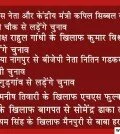- Former secretary to Kejriwal transferred to Urban Development deptPosted 2 days ago
- Breaking: Kiran Bedi joining BJP, may contest against Arvind KejriwalPosted 3 days ago
- Rajmohan Gandhi, grandson of Mahatma Gandhi joins Aam Aadmi PartyPosted 2 weeks ago
- Aam Aadmi Party organises ‘jhadoo’ rally at NahanPosted 2 weeks ago
- Delhi government to continue MLA local area development schemePosted 2 weeks ago
- Arvind Kejriwal’s Aam Aadmi Party moves Supreme Court against President Rule in DelhiPosted 2 weeks ago
- Breaking: Bangalore’s Tech Community will Supports Aam Aadmi PartyPosted 2 weeks ago
- Surprise support for Arvind Kejriwal, from Nitish KumarPosted 2 weeks ago
- All AAP govt schemes will continue, Lieutenant governor Najeeb JungPosted 2 weeks ago
- Breaking: Indian hockey legend Dhanraj Pillay joins Aam Aadmi PartyPosted 2 weeks ago
Everything about Kejriwal’s Swaraj Bill 2014
Even before the Jan Lokpal Bill is tabled in Delhi Assembly, the Arvind Kejriwal-led Aam Aadmi Party has come up with its Swaraj Bill which, it says, may prove to be the flashpoint that will pit the AAP against the Congress, BJP and independents in the House.
Through this bill, the government wants to make the people of the city a part of the decision-making process.
Under Swaraj, every ward in the city will be divided into eight to 12 mohallas and any work in that mohalla would be undertaken after consultation with the residents and a nod from the mohalla sabha.
So what does this bill aims at?
The Swaraj Bill intends to decentralize power by segregating the city into 2,720 mohalla sabhas, which will have functions ranging from the cleaning of roads.
• Each municipal ward to be divided into maximum of 12 mohallas to be carved out from a residential block, colony or community rather than merging parts of one block, colony or community into others
• State Election Commission to notify mohalla after seeking public objections and suggestions
• All registered voters residing in a mohalla are part of mohalla sabha. They make up a general body
• Homeless, even if non-voters but above 18 years registered with DUSIB or any agency notified by it as ordinary residents of that area are part of mohalla sabha
• Every five years, boundaries may be amended by commission if a mohalla sabha recommends on basis of two-third majority
• A mohalla committee will be formed with two mohalla sabha representatives—one man and one woman—elected by the sabha by a single transferable vote. Transgenders can opt to be elected as male or female
• State Election Commission to conduct these non-party polls. Any registered voter of mohalla who is above 21 years of age may file his nomination for post of representative. S/ he should not be holding an office of profit or be an elected member elsewhere like the municipal corporation. Also the person must not be disqualified under law to contest
• The representative must get at least 50% votes of the mohalla sabha. The tenure is five years
• Mohalla sabha meetings at fixed place once a month. To be co-chaired by the two elected representatives
• Quorum for any sabha meeting shall be 10% of registered voters of which 33% shall be women.
• All meetings will be video recorded and saved as public records by mohalla sewak in mohalla secretariat manned by official functionaries
• A ward area committee will have the two representatives of each mohalla sabha on board with the area municipal councillor as chairperson.
• They will meet once a month to take decisions
• 20% or more of registered voters of a mohalla sabha can seek removal of a representative. On their appeal, State Election Commission can order a vote on recall of representative. Two-third votes decisive
• Even a councillor can be removed if 50% of mohalla sabhas or 10% voters of municipal wards petition State Election Commission. A poll can be accordingly conducted
• Universal education and healthcare in mohalla
• To direct and authorize expenditure for welfare of people of mohalla
• No land use conversion without sabha’s permission
• Slums can be removed only with permission of sabha and after requisite resettlement plan



deep kamal tiwari
February 12, 2014 at 8:28 pm
nice concept…mere kuch sujhav hai
1-Is concept ko aage chalkar vidhayak aur sansado ko recall karne k liye bhi use kiya ja sakta …
In sabhao k madhyam se kisi vidhayak ya sansad ko recall karne k liye janmat tayar ho sakta hai…
Present time me yahi sabse badi dikkat dekhi jati hai .
2- history me chol shashan me is tarah ki hi wyawastha thi …waha se wo visheshtaye li ja sakti hai jo aaj useful hai ..
anubhav sharma
February 12, 2014 at 10:53 pm
What are our plans for issues like kashmiR and how will we deal with pakistan and china? Development of the nation? Terrorism?